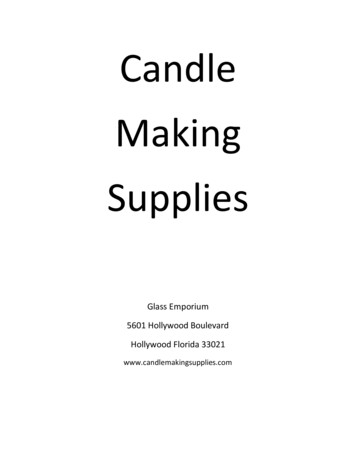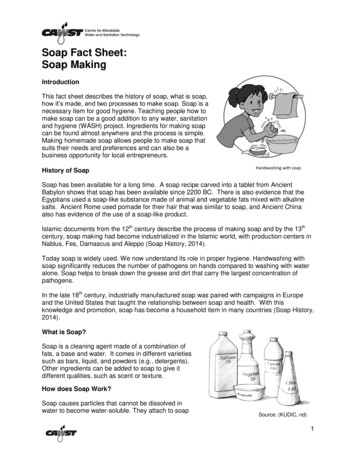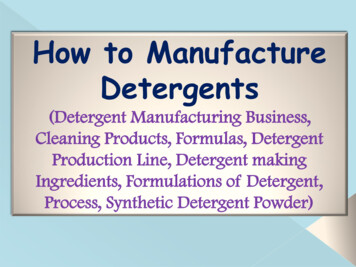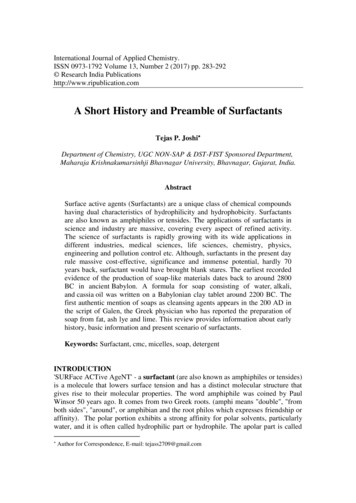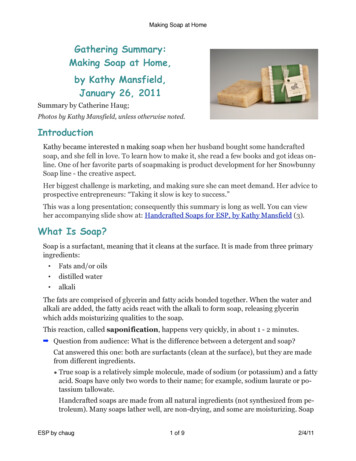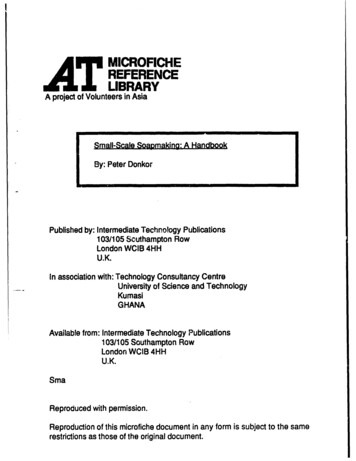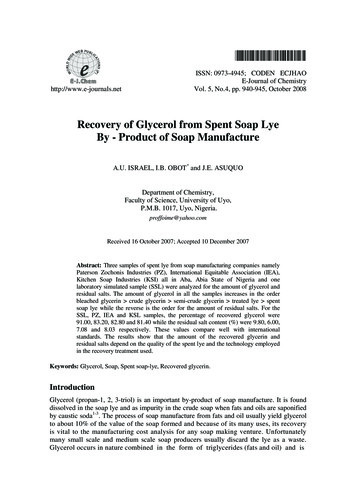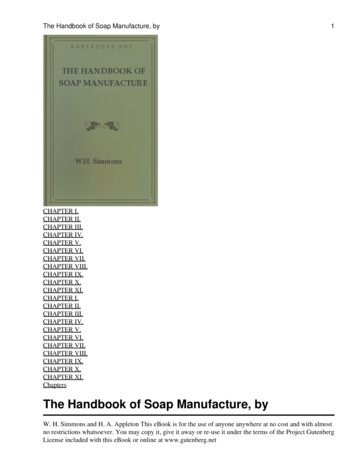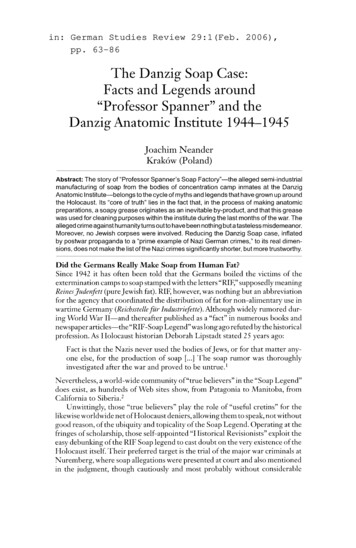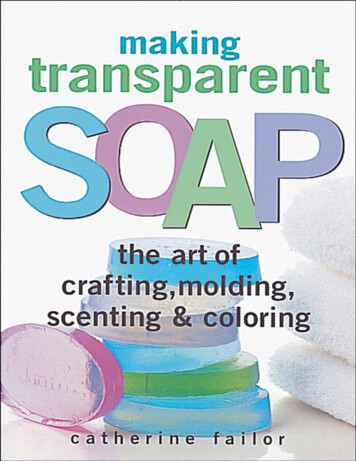
Transcription
making transparent SOAP
making transparent SOAPthe art of crafting, molding, scenting & coloringcatherine failor
The mission of Storey Publishing is to serve our customers bypublishing practical information that encouragespersonal independence in harmony with the environment.Edited by Deborah Balmuth and Robin CatalanoCover design by Carol Jessop, Black Trout DesignCover and interior photographs by Giles Prett except those by Jeff Burke and Lorraine Triolo for Artville on pages 83 and 85; Eyewire Images on pages 17, 20, 82, 84, 97, 103, 120, and 134Illustrations by Terry DovastonText design and production by Mark TomasiProduction assistance by Susan BernierIndexed by Barbara Hagerty 2000 by Catherine FailorAll rights reserved. No part of this book may be reproduced without writtenpermission from the publisher, except by a reviewer who may quote briefpassages or reproduce illustrations in a review with appropriate credits; normay any part of this book be reproduced, stored in a retrieval system, ortransmitted in any form or by any means — electronic, mechanical,photocopying, recording, or other — without written permission from thepublisher.The information in this book is true and complete to the best of ourknowledge. All recommendations are made without guarantee on the part ofthe author or Storey Publishing. The author and publisher disclaim anyliability in connection with the use of this information. For additionalinformation please contact Storey Publishing, 210 MASS MoCA, NorthAdams, MA 01247.Storey books are available for special premium and promotional uses andfor customized editions. For further information, please call 1-800-793-9396.Library of Congress Cataloging-in-Publication DataFailor, Catherine.Making transparent soap : the art of crafting molding, scenting, and
coloring /Catherine Failor.p. cm.ISBN 978-1-58017-244-8 (pbk. : alk. paper)1. Soap. I. Title.TP991.F262 2000668′.12—dc2199-055700CIP
DedicationThis book is for my parents, Letitia and the lateRobert Failor, for their love and support.
AcknowledgmentsMany, many thanks go to my good friend Kay Whaley, who has been aconstant source of inspiration, ideas, and support throughout the writing ofthis book.A grateful acknowledgment goes to Elaine White for her time andvaluable suggestions.A few years ago, when she started work on The Natural Soap Book, SusanMiller Cavitch called me up for help. What little help I could offer has beenreturned many times over through her kind encouragement. Thanks, Susan.Thanks to John Toso at Sappo Hill, my best friend in the soap business.To the Portland Public Library — I can’t count the times I called thereference desk. What would life be without our libraries?Many thank-yous to all these helpful people: Clyde Abston, CharlieSchmalz, Luis Spitz, George Whalley, Ed Paladini, Peter Cade, JohnPrutsman, Jim Bronner, Ken Peterson, and Peter Fox.
contentsIntroductionChapter 1: All About SoapChapter 2: Knowing Your IngredientsChapter 3: Equipment & Safety PrecautionsChapter 4: Making Transparent SoapChapter 5: Transparent Soap RecipesChapter 6: Dyes & FragrancesChapter 7: Labor-Saving ToolsChapter 8: TroubleshootingBibliographyGlossaryResourcesIndex
introductionZilch. That’s how much informed, practical information on transparent soapmaking is currently available to the amateur soapmaker. Why? Not becausethe process requires a Ph.D. in chemistry or exotic and expensive chemicalingredients impossible for the layperson to obtain. It doesn’t. If you canfollow a recipe from a cookbook you can make transparent soap, and youdon’t need to look much further than your supermarket, drugstore, and liquorstore for all the necessary ingredients.Opaque soaps have been manufactured for at least two thousand years, buttransparent soap is a relative newcomer — the first bars were producedalmost exactly two hundred years ago. So information regarding itsmanufacture hasn’t been circulating for as long or as widely as informationconcerning opaque soap. The descriptions that do exist are scanty and oftenconfusing. And as is typical with many manufacturing processes, tradesecrecy has constricted the informational flow down to a dribble. It’s just notin the best interest of Neutrogena or Pear to publish a detailed treatise ontransparent soapmaking.I was in business 5 years as a soap-maker before attempting to maketransparent soap. It was a bit overwhelming. All the information pertaining tothe manufacture of transparent soap resembled a jigsaw puzzle with half ofits pieces missing. But the challenge was there. Several months of trial-anderror experimentation ensued, and most batches ended up in the garbage can.Finally came the day when information and observation joined to create thebig picture. That’s what this book contains — all of the relevance with, Ihope, none of the confusion.Soapmaking is a lot like cooking. The ingredients are measured, mixed,heated, and poured into pans or molds. If your kitchen contains the basicutensils needed for cooking, you’re all set. The spoons, whisks, spatulas, andpots used to make chicken soup or bake a chocolate cake can be used to maketransparent soap. An accurate scale is something you might not have, but thatcan always be borrowed from a friend or purchased secondhand.Transparent soap consists of the same base that opaque soap does —
animal or vegetable oil combined with lye. Lye usually elicits a strongreaction from the uninitiated. “Lye? You mean there’s lye in soap? Lye is apoison!!!” But the chemical world is full of beasts turned beauties — it’s justa matter of marrying well. Lye combined with oil is no longer lye, and oilcombined with lye is no longer oil. Soap and glycerin are born.Transparent soap contains a few things that opaque soap doesn’t. Thesearen’t mysterious chemicals with impossible-to-pronounce names. In fact,you’re sure to have one of the ingredients sitting on your kitchen table —ordinary granulated sugar. Another additive, 190-proof grain alcohol, orethanol, might be tucked away in the liquor cabinet. You probably won’thave a bottle of glycerin on hand, but it’s easily found at most drugstores.I hope this will be enough to dispel any initial reluctance you might haveabout making transparent soap. After all, every bath and body retail chain onthe planet is making it, so why don’t you? I guarantee that handmadetransparent soap will feel softer, richer, and creamier than any commercialbrand on the market.
1all about soapSoapmaking is one of the oldest industries in the world, although no onereally knows just when soap was discovered. The first reference to soapoccurs in Sumerian clay tablets dated about 2500 B.C., but this was probablynot a true soap. The early Romans used hot water and scraped their bodieswith twigs or a special tool called a strigil. Some sources indicate that theGauls were the first people to make soap and that the later Romans, duringthe conquests of Julius Caesar, learned the art from them. Excavations ofancient Pompeii reveal the presence of a soap factory.Soapmaking as an art and science has been so refined that much modern“soap” is no longer soap in the true sense of the word. These soaps, which areactually synthetic detergents, became popular during World War II inresponse to a shortage of soapmaking oils. Many techniques now used by thehome soapmaker are revivals of pre-twentieth century soapcrafting.
early soapmakingSoap manufacture flourished in Europe from the eighth century onwardin such towns as Castilla in Spain, Marseilles in France, and Savona inItaly.The city name of Savona is the source of the names savon, sabon, andjabon, which mean “soap” in French, Portuguese, and Spanish, respectively.These earlier soaps were available only to the rich; it wasn’t until thenineteenth century that soap of decent quality could be afforded by thecommon person.Probably the first and certainly the best-known transparent soap is Pears.In 1798, Andrew Pears opened a barbershop in a fashionable Londonneighborhood. As business grew he began making his own creams, pomades,and powders. The soaps available at that time were often crude and quitealkaline, so Pears set about experimenting with his own formulas. Hediscovered that when he dissolved ordinary soap in alcohol, the resultingsoap was both mild and transparent. Mass production began, and with thepromotional help of his son-in-law, Thomas J. Barratt, sometimes called thefather of advertising, Pears created a market that still retains a loyal followingsome two hundred years later.
Soap can be produced in a variety of ways, but until now, home soapmakersused the cold-process method.what is soap?Soap is the by-product of a chemical reaction called saponification. Fattyacids present in either vegetable or animal oils are combined with astrong base, or alkali, namely caustic soda or caustic potash. Sodiumbased (soda) soaps are hard; potassium-based (potash) soaps are liquid.Large-scale commercial production of soap is done in enormous steamheated vats by use of the full-boiled method. This process allows for thegreatest control, because any unreacted lye can be removed at the end of theprocess. Some smaller specialty soap companies and the home soapmaker usethe cold-process method, whereby the heat generated from the reaction offatty acids and alkalis enables the soap to form. These soaps are usually lessneutral than full-boiled soaps. Transparent soap is made by the semi-boiledmethod. The oils and caustic solution are combined and then heated, thoughnot to the boiling point.A neutral pH is 7. The pH of our skin ranges between 5 and 6.5, which issomewhat acidic. “Neutral” soaps are quite alkaline, with a pH of about 9.5.This wide discrepancy between our skin’s pH and the pH of soap explainswhy so many soaps are drying to the skin.This problem can be somewhat corrected by superfatting, or adding an
excess of fatty acids or oils. Another process involves both superfatting thesodium soap and blending it with a soap created from the chemicalcompound called triethanolamine (TEA). The resulting soap is bothextremely mild and easily rinsed off. The inventor of the process referred tothis property as “neutrogenous,” and that’s how Neutrogena soap was born.A strong bristle brush helps exfoliate dead skin cells before washing.How Does Soap Clean?Soap has been cleansing us for centuries without anyone’s knowing justhow. The answer lies in the molecular structures of water, oil, and soap.Water is a bipolar molecule. One of its ends, two hydrogen atoms, ispositively charged; the other end, an oxygen atom, is negatively charged.This bipolar nature gives water a cohesiveness that resists being broken apart;you may have noticed that a drinking glass can be filled with water until thewater is actually standing above the rim without overflowing. Water’s lovefor itself makes it particularly incompatible with oil. This is because oil hasan electrical charge that is uniform; there are no positive and negative polesto the molecule. What is needed to bring water and oil together is a substancethat resembles them both — partly polar, partly nonpolar, able to act as anintermediary. That’s what soap is.During saponification, the fatty acids combine with the caustic sodium orpotassium to form a soap molecule. One end of this molecule is composed ofthe water-soluble sodium or potassium group; the other end consists of thewater-insoluble fatty acid group. This molecule looks like a snake, with asodium “head” and a fatty acid “tail.”
A loofah sponge is made from the loofah gourd, a plant that grows in NorthAmerica.UNIQUE QUALITIES OF TRANSPARENT SOAPBecause of the presence of additives, a transparent bar of soapcontains only about 50 to 60 percent actual soap. Opaque barscontain approximately 85 percent. This difference explains whytransparent bars have shorter life spans in your shower and sink.And even though both transparent soap and opaque soap haveabout the same pH, transparent soap rinses off the skin much morereadily. This accounts for its exceptional mildness.When soap is added to plain water, it doesn’t actually dissolve. Whathappens is that the fatty tails hurry to the surface to avoid contact with thewater and align themselves tail-up in the air. This breaks the water’s surfacetension and causes it to spread. If you take some soap solution and add it to
that nearly overflowing glass of water, it will immediately cause the water tocascade over the rim of the glass.Soil is usually enveloped in an oily film. When soiled fabrics or oils areadded to soapy water, the fatty tails of the soap rush to them, seeking to bondwith a substance of similar molecular makeup. These tails act as tinyhammers, chipping away at the soil and grease. The grease then balls up intosmaller droplets. With the soap’s oil-loving tails embedded in the grease andits water-loving sodium heads straining outward toward the water in thebasin, the grease and grime can be washed down the drain.Opaque Soap, Transparent SoapDuring part of the soapmaking process, all soap passes through a colloidalphase. A colloid is any gel-like insoluble substance made up of particleslarger than molecules but small enough so that they remain suspended in afluid medium without settling to the bottom. If you’ve ever made soap andpeeked at it while it is curing in the molds, you might have noticed that at onepoint the soap appears as a translucent gel. This is the colloidal state.As the soap cools, long fibrous crystals begin developing. They increase innumber and length and enmesh with one another. Gradually the translucencyof the colloidal state disappears and the soap becomes opaque. This isbecause the increasing number of crystals renders the soap impervious to thepassage of light waves. These crystals are what give ordinary bar soap itsopacity.Throughout this book you’ll find several safety precautions. Inorder to fully protect yourself during the soapmaking process, besure to follow each caution carefully.
A natural sea sponge offers a tight, yet absorbent, skin-scrubbing tool.
Transparent soap, with its myriad colors, scents, and shapes, brightens anybathroom or kitchen.Transparent soap is made by the same initial process as opaque soap. Butat the point when the soap gels, solvents are added. Glycerin, ethyl alcohol(ethanol), and ordinary table sugar are the solvents described in this book.These solvents hold the soap mass in the colloidal state and suppress thedevelopment of long crystals. Transparent soap does contain crystals, butthey are so exceedingly small that light waves can pass right through the bar.Transparency is defined as the ability to read 14-point typeface through a ¼"thick sliver of soap.Make bathtime fun for both children and adults with the addition of tub toys,bath beads, and vibrant transparent soap.
2knowing your ingredientsMost of the things we’re surrounded with in our lives are so commonplacethat we rarely stop to consider just what they really are made of. This isespecially true in the modern industrialized world, because almost all of ourmaterial goods are made by a machine or another person, usually thousandsof miles away. But whether you’re baking bread, glazing pottery, or buildinga cabinet, success always hinges on a knowledge of each material’scharacteristics and how one material affects another.Soapmaking is no different. Each fat and oil used to produce a bar of soaphas its own unique chemistry, which affects the soap’s hardness, solubility,and lather. This chapter is intended to deepen your understanding of eachingredient’s characteristics, which will be useful for problem solving or forformulating your own soap. Chapters 4–6 contain charts and furtherinformation on soapmaking.
fats and oilsThe difference between a fat and an oil is somewhat arbitrary and isbased on physical state at room temperature — fat is solid; oil is liquid.Oils are divided into three classes: mineral oils (derived from petroleum),essential oils (any volatile oil that gives a distinctive fragrance to a plant,flower, or fruit), and fixed oils. Fixed oils, which are either animal orvegetable in origin, constitute the main raw materials for soap-makingbecause of their easy reactivity with alkalis. Specifically, the fatty acids inthese oils are what combine chemically with the alkalis; this process isknown as saponification. The fixed oils are further classified as follows:Hard fats are largely composed of stearin and palmitin, fatty acids thatare solid at room temperature and therefore lend firmness to the fats; thisfirmness, however, means that soaps created from hard fats do not readilydissolve in water. A soap composed exclusively of either palm oil or tallowwill be very brittle, with a low but persistent lather.Palm oil and animal tallow are the two most common hard fats used for
soapmaking. Palm oil is extracted from the fruit pulp of the oil palm and isbecoming increasingly difficult to find in the United States because of healthconcerns over saturated fats in our diets. Wholesale bakery or grocerysuppliers are the most likely sources for 35-pound pails. Other suppliers arelisted in Resources.Tallow is the fat of cattle or sheep; suet is the fat specifically surroundingthe kidneys of these animals. Tallow and palm oil can be usedinterchangeably in soap formulation, although tallow may worsen skinconditions such as eczema and acne. It has been the primary fat used insoapmaking for two millennia and is much easier to obtain than palm oil.Simple instructions for rendering tallow are outlined on the facing page.An oil is a type of fat that is liquid at room temperature.Rendering TallowIf you haven’t any philosophical objections to animal-based soap, you canuse lard, which is found in 1-pound blocks at your grocery, or you can rendertallow. Rendering needs to be done a day before soapmaking.Tallow can be purchased from butchers or from rendering plants. Itusually comes in large slabs, though some butchers grind it up into
hamburger consistency for customers with bird feeders. Hamburgerconsistency is ideal; the smaller the pieces, the faster the rendering time. Buymore fat than the recipe calls for, since there are some impurities that will bediscarded after rendering. If a recipe calls for 2 pounds of tallow, buy 3. Andas long as you’re going through the trouble of rendering, make some extranow if you’ll be mixing more soap in the future. It keeps indefinitely in thefreezer.To render, chop the tallow into small chunks. In a large pot, bring to a boila few cups of water. (Some opaque soap-making books call for salted water,but salt can cause cloudiness in transparent soap.) Add the fat carefully toavoid splashing. Stirring occasionally, bring the water back up to a boil, thenturn the heat to low, and cover the pot. Depending on the amount of fat beingrendered, it may take a few hours until all the fat has melted. If you’reimpatient, you can expedite the process by chopping up the hot chunks of fatin a blender or food processor.WHAT ABOUT LARD?As an alternative to palm oil and tallow, lard can be used. Lard isrendered pig fat. One big advantage of lard is that you can buy itcheaply in 1-pound cubes at most grocery stores, already cleanedand refined. Soap made with lard is a bit softer than soap madewith palm oil or tallow.Once the fat has completely melted, pour it through a large strainer andinto another pot or bowl; toss out any of the impurities that might be left inthe strainer. Let the fat cool to room temperature, then set it in the refrigeratorovernight. By the next day, the fat will have cooled into three layers: whitetallow on top, a middle grayish granular layer, and water or gel on thebottom. Lift the disc of tallow, and scrape away all of the gray layer adheringto it.This disc of white tallow will soon be transformed into a clear, jewellikebar of transparent soap.
Nut OilsCoconut oil and palm kernel oil are the most typical nut oils used for soapmaking. Coconut and palm kernel oils are characterized by a large proportionof lauric acid, which produces a very soluble and quick-lathering soap. (Notall nut oils have this high percentage of lauric acid.) What is unusual aboutlauric acid is that it also produces a hard soap; all other oils capable ofhardening soap have the disadvantage of poor solubility. Soaps createdexclusively from coconut or palm kernel oil, however, are drying to the skin,and though they lather profusely, the lather is short-lived.Coconut oil is pressed from dried coconut meat (copra), and palm kerneloil is extracted from the kernel (as opposed to the fruit) of the oil palm.Coconut oil can be purchased at most health food stores; 35-pound pails canalso be found at large grocery wholesalers or bakery supply houses. Palmkernel oil is not as easy to find. For more information, consult Resources.Both of these oils have similar soap-making properties and can be usedinterchangeably. However, more sodium hydroxide is necessary to saponifycoconut oil than is needed for palm kernel oil. The recipes in this book havebeen calculated for coconut oil only. If you wish to use palm kernel oil inplace of coconut oil, see Formulating Opaque and Transparent Soap in
chapter 5 and recalculate. Palm kernel oil requires approximately 80 percentof the amount of sodium hydroxide needed to saponify coconut oil.One of the most popular oils for soapmaking is created from the commoncoconut.Soft OilsUnsaturated fatty acids, such as oleic acid and linoleic acid, are theprimary components of most soft oils: olive, cottonseed, corn, canola,soybean, sesame, and peanut oils are common soft oils. The soapmakingproperties of these oils vary according to the proportions of each oil’s fattyacid content, but generally soft oils yield thin, long-lasting lathers with gooddetergent properties. None of these oils should be used alone for soapmaking,however, as they cannot produce a hard bar.Note: Avoid sulfonated castor oil, which is water soluble; this willcause an oil blend to “seize” and curdle as soon as the lye solutionis added.
Although soft oils are not used alone in transparent soapmaking, they lendvaluable lathering and detergent properties to the finished product.Castor oil, a thick, viscous oil extracted from the castor bean, is thetraditional soft oil of choice for transparent soapmaking. Castor oil differsfrom most other soft oils in its fatty acid composition; 80 to 85 percent ofcastor oil is ricinoleic acid. The peculiar nature of this fatty acid gives castorsolventlike properties, and solvents are what render ordinary soaptransparent. Other soft oils can be substituted for castor oil, but the resultingsoap will be somewhat less transparent.Castor oil has the additional virtue of acting as a humectant: it draws and
holds moisture from the air to the skin. Too large a proportion of castor oil ina recipe, however, makes the finished bar soft and sticky and reduces itslathering properties. Castor oil can be found in or ordered from drugstoresand health food stores. Other sources are listed in the back of this book.Blending OilsYou can see from the previous description of oils that any single oil usedalone will not produce a satisfactory bar of soap — the soap will be too hard,too soft, or of insufficient lather. One of the arts of soapmaking lies in theselection and blending of oils. The best soap consists of coconut or palmkernel oil for firmness and quick foam; a hard fat for firmness and forstabilizing and extending the life of the lather; and a soft oil for a rich,soluble lather. For readers who are interested in formulating their own soaps,chapter 5 contains additional information. Consult the chart on the facingpage for at-a-glance information on the different fats and oils.Castor oil creates a rich, creamy lather and helps moisturize the skin.
other ingredientsSince soap consists of an oil-and-water bond, certain ingredients areneeded to help form this bond.AlkalisThe two alkalis used in soap production are sodium hydroxide, also calledlye or caustic soda, and potassium hydroxide, or caustic potash. Soda-basedsoaps are solid; potash-based soaps are liquid. Caustic soda is used for all thetransparent soap recipes in this book.Commercially, caustic soda is produced by the electrolysis of brine(seawater); the other by-product of this process is chlorine, used forbleaching and water treatment. Caustic soda is most frequently found ineither bead or flake form; large soap operations purchase it as a liquid. Youcan find pure lye in 12-ounce cans in the cleaning section of your localsupermarket; look for Red Devil brand. Don’t use Drano; it’s not pure lye. Ifyou plan to make a lot of soap, the cheapest and easiest alternative is a 50pound bag, which can be purchased from chemical wholesalers in your area.Other sources of caustic soda are listed in Resources.Caustic soda is extremely hygroscopic, or water-loving; a small bead willquickly swell up with atmospheric moisture and become a large droplet. Caremust therefore be taken in storing any half-used containers. Caustic soda isalso extremely corrosive — it burns skin within seconds of exposure. Glovesand goggles are a must during the handling and mixing of lye solutions andduring the mixing of the soap itself.IN CASE OF ACCIDENTAL EXPOSURE TO LYEIn case of exposure of lye to the skin, always keep a bottle ofvinegar or lemon juice handy — the strong acid quickly neutralizesthe strong base of lye. This works faster than rinsing with plainwater, but don’t use vinegar or lemon juice in the eyes or if the lyehas been ingested — seek immediate medical attention. The rulefor caustic soda is the same as that for any hazardous substance:
read the warning labels!Distilled or Soft WaterWhether you’re making transparent or opaque soap, water will be mixedwith caustic soda to create a lye solution.Transparent soaps require additional water in the form of a sugar solution.Tap water is not recommended; depending upon where you live, it cancontain dissolved salts and other mineral impurities that may impart acloudiness or “efflorescence,” as transparent soapmakers say, to the finishedbar of soap. These salts and minerals act as “seeds” around which otherimpurities can coalesce, much as pearls form around grains of sand inside anoyster. For this reason, distilled or soft water is strongly recommended fortransparent soap.Water also contributes to the soap’s transparency because of its nature as asolvent. Even though much of this water eventually evaporates, the soapretains its transparency.
Water is an essential ingredient in any soap recipe. Use distilled or softwater for best results.AlcoholAlcohol is the primary solvent used in transparent soapmaking. After theinitial batch of soap has been mixed and left to sit in the pot for a couple ofhours, alcohol is added. With a little stirring, the alcohol dissolves the soapinto a clear, amber liquid. Some old soap manuals claim that it’s possible tomake transparent soap without alcohol; additional glycerin and sugar solutionare used instead. But a soap made without alcohol will likely cloud with age.Ethyl alcohol (or ethanol), more commonly known as 190-proof grainalcohol, is the type of alcohol required for all the recipes in this book.
Ethanol, colorless and extremely flammable, is produced by the fermentationof starches, sugars, and other carbohydrates. Less expensive isopropylalcohol can be substituted for a certain amount of ethanol. (Isopropyl alcoholis prepared from propylene, a gas obtained during the refinement ofpetroleum.) But because ethanol is a stronger solvent than isopropyl alcohol,soap made with an ethanol/isopropyl blend will be less transparent.Ethanol can be purchased through scientific and chemical supply houses.It is referred to as denatured, and it costs considerably less than liquor storeethanol, particularly when you purchase by the gallon. The trick is to find itin your local area. Although some suppliers are listed in Resources, shipperssuch as United Parcel Service consider ethanol a hazardous substance owingto its flammability. An extra fee (besides the shipping cost) is consequentlyadded to the denatured alcohol. Its cost may then end up equaling or evenexceeding the cost of liquor store ethanol. To find denatured alcohol in yourhometown, look in the yellow pages under Scientific Instruments andSupplies or Chemicals.Being creative when choosing scents, colors, and molds for your soaps willturn the predictable into the unexpected.Ethanol is denatured to make it unfit for drinking or redistillation. Manysubstances are used as denaturants — essential oils, ketones, vinegar,benzene, bone oil — to name just a few. Many of these denaturants are eithertoxic or strong-smelling, making them unsuitable for soapmaking.Two denatured alcohols that are acceptable for use in soaps and shampoosare SDA 3A and SDA 3C. SDA stands for Specially Denatured Alcohol.SDA 3A is composed of 100 parts ethanol to 5 parts methyl alcohol. SDA 3Cis 100 parts ethanol to 5 parts isopropyl alcohol. So when ordering denaturedethanol, be sure to specify either SDA 3A or 3C.
WHERE TO BUY ETHANOLEthanol can be found at your local supermarket or liquor store.The most common brand names are Clear Springs and Everclear.When purchasing bottles for soapmaking, keep in mind that 1 fluidpint of alcohol doesn’t weigh 1 pound; alcohol has a lower specificgravity than water. One pint of alcohol weighs roughly 12.5 ounces.GlycerinThe term glycerin soap has come to be synonymous with transparent soapeven though transparent soap can be made without it. Nonetheless, most ofthe recipes in this book do include glycerin. Not only is glycerin an excellentsolvent, but, like castor oil, it acts as an emollient and a humectant, drawingmoisture from the air and holding it to the skin. When glyceri
nineteenth century that soap of decent quality could be afforded by the common person. Probably the first and certainly the best-known transparent soap is Pears. In 1798, Andrew Pears opened a barbershop in a fashionable London neighborhood. As business grew he began
